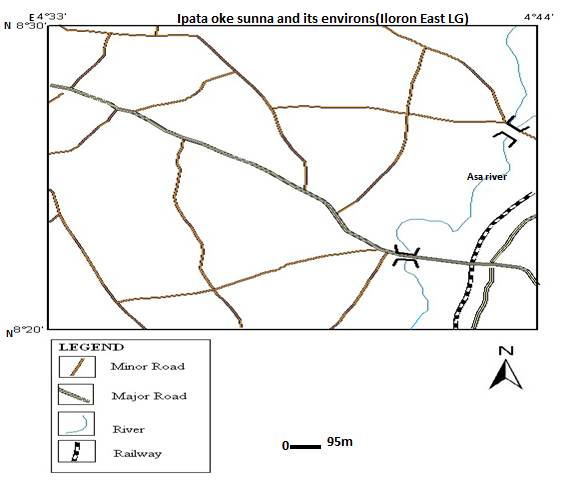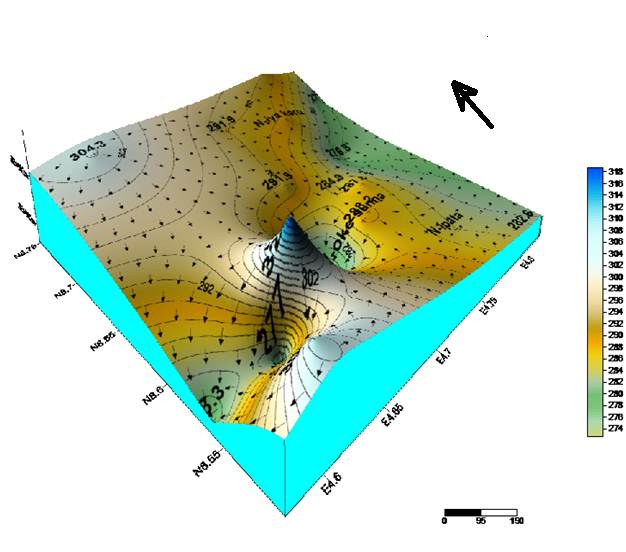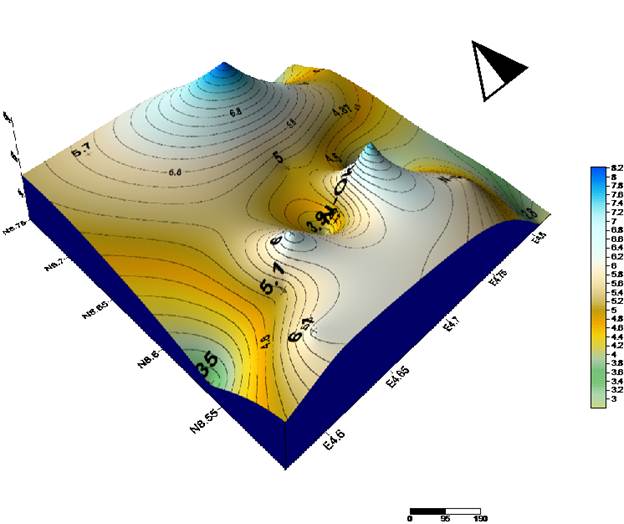GROUNDWATER QUALITY IN DUMP SITE AREAS
CHAPTER ONE
1.0 GENERAL INTRODUCTION
The total amount of water in the earth is virtually constant but it’s distribution over time and space varies to a great extent. Wherever people live, they must have a clean and continuous supply of water as a primary requirement of human beings. The assessment of quality, supply and renewal of water is a well known problem, but it is becoming critical with the growth of population and rapid industrialization in Nigeria.
The rising population in Nigeria of about 180 million requires knowledge of proper waste disposal. Wastes are dumped recklessly with little environmental regards in major cities of many states in Nigeria including Kwara state. Increase in population, changes or improvement in wages, massive expansion of the urban areas and the changing lifestyle or better standard of living, as well as improvement in technology in Nigeria has encouraged solid waste generation (UNICEF 2001). Although solid waste is an asset when properly managed. Its volume has continued to increase tremendously in recent times. In Nigeria, much has been, and is being, invested on municipal solid waste management in cities. Little progress has been made because of severe financial, technological and institutional constraints within the public and the private sectors. There is erratic growth of housing units in the inner core of urban cities (Ojeshina, 1999; Omishakin and Sridhar; 1985).
Waste can be defined as any material lacking direct value to the producer and so must be disposed off. Similarly, waste is any material that is thrown away as unwanted material (UNICEF 2006). The trend of uncontrolled and haphazard construction of groundwater facilities particularly shallow wells in the residential area with refuse sites is of great health concern, as this may contribute significantly to adverse impact of the aquifer as a result of overdependence and over abstraction with attendant negative effects.
The term ''solid waste'' means any garbage, refuse, or sludge from a waste treatment plant, water supply treatment plant, or air pollution control facility and other discarded material, including solid, liquid, semisolid, industries mining ets. Solid waste can however be classified into different types, depending on their source; household waste is generally classified as municipal waste; industrial waste as hazardous waste, and biomedical waste or hospital waste as infectious waste.
1.1 PROBLEM STATEMENT
According to (Marshal, 1995), open dumpsites are a major problem to the environment, especially on the air that the people inhale. Dumpsites emit obnoxious odours and smoke that cause illness to people living in, around, or closer to them. Dumpsites maybe a source of airborne chemical contamination via off site migration of gases and the particles and chemicals adhering to dust, especially during the period of active operation of the site. Contamination of soil and groundwater may lead to direct contact or pollution of indoor air, for example in the case of volatile organic chemicals into basements of nearby residents and in the case of consumption of home grown vegetables as well and volatile organic chemicals have been detected in odored air of homes nearby
Attempts by Nigeria government, groups and individual to check these problems include composting, open burning and refuse dumping in rivers. These attempts had severally failed because of their inadequacies (Ige, 2003 and Asiwaju-Bello, 2004). The general belief that wastes are sometimes hazardous to health cannot be overemphasized. According to (Porteous , 1985), “Hazardous waste can cause and has caused pollution, damage to health and even death”. The environmental problem posed by solid wastes ranges from health hazard, soil and water pollution, repulsive sight, offensive odour and occupancy to increase in ambient temperature levels. These are most experienced where the waste are not properly disposed off or managed. The resultant effect of these is the degradation of our environmental quality.
Wastes are dumped in water dumping bodies across the major cities in Kwara state. Also the municipal wastes are collected and burnt in the open space in Oke Sunna and Iya Kororo dumpsite while untreated waste are allow to run through the water bodies in Ipata to large river e.g Asa .The practice of burning and streaming discharge of industrial waste, destroy the organic component, oxidizing metal, thereby enriching the ashes left behind in metal. The leachates from these dump site percolate the soil and pollute the aquifer in the surrounding areas thereby affecting the water qualities. The realization of the polluting effects of landfill leachates on the environment has prompted several studies. These include studies on domestic wastes (Sridhar et al, 1985), leachate quality (Aluko et al, 2000), as well as underground water quality (Loizidou and Kapetanios, 1993).
1.2 AIMS AND OBJECTIVES
- AIMS
- To evaluate the pollution potential due to toxic metals from dumpsite and impact on the quality of groundwater in selected areas
.
1.2.2 OBECTIVES
This project examines spatial variation in solid waste composition and management in Ilorin Metropolis and these objectives include:
- To assess the water quality of the study area.
- To determine the extent of ground water pollution in the study area.
- To determine effect of water pollution if any.
1.3 THE STUDY AREA
Waste management is the collection, transportation, processing, recycling or disposal of waste materials. Olorunfemi and Odiata (1998) reported that lack of solid waste data in Ilorin is the most conspicuous and probably most important problems militating against the successful management of solid waste effectively by the Nigerian Waste Management Authorities.
The city of Ilorin falls into southwestern and North central on geological and political classifications respectively. It is the capital town of Kwara State, Nigeria, with a population estimate of 2,185,494 people (NPC, 2007) which is responsible for the generation of waste often deposited in open spaces, river banks, road side etc. thereby degrading the quality of the environment, Ilorin comprises of three Local Government Areas namely: Ilorin West, Ilorin Ilorin South and Ilorin east which is the study area.
The study area (Ipata-Oke Sunna and its environ) is located within latitude 80 29.400’’ N and 80 30.500’’ N and longitude 40 33.00’’ E and 40 34.500’’E. The approximate area extent of the Ipata slaughter house is 1.5.0x102m2 while the dumpsite in Oke Sunna has an approximated area extent of 2.5 x102 m2 and that of Iya- Kororo dumpsite has an approximated area extent of about 2.3 x102 m2. The inhabitants of these areas are mostly traders. Geologically, the area lies on the Precambrian Basement complex of southwestern Nigeria and is underlain by rock of metamorphic and igneous type. However, migmatite predominantly underlies the waste dumpsite and characterized by weathered regolith which vary in thickness from place to place. The hydrologic setting of the area studied is typical of what is obtained in other Basement complex area where the availability of water is a function of the presence of thick-little clay overburden material and presence of water filled joints, fracture or faults within the fresh Basement rocks, these makes it a good ground for a study of this nature
In Ipata – Oke sunna and its environ, animal waste are allowed to run directly into Asa river, and mountain of refuse in Oke sunna are left uncleared and unmanaged. There are 21 dumpsites in Ilorin 108 roro bin but none was found in Ipata-Oke Sunna and its environ. Lack or inadequate waste disposal situation is manifestation of improper waste disposal scheme within easy reach of the communities and the industries in these areas.
1.4 CLIMATE AND VEGETATION
According to Ifabiyi (1999), the climate of the city of Ilorin is tropical continental with high temperature throughout the year. It is characterized by wet and dry seasons. Ilorin falls within derived savannah vegetation, covered with the existence of dry lowland rain forest vegetation cover. The wet season is between March and October while the dry season is between the months of November and February. The total annual rainfall in the boundary of the state in the north ranges from 800mm to 1,200mm, in the northwestern parts of the state we have 950mm to 1,300mm while in the southeast is 1,000 mm to 1,500mm
Kwara state has several rivers which include: river Asa, Awon river, Oshin and Moro in the central state with a mean temperature of 300C to 350C while humidity is relatively moderately high. The amount of rainfall in the southern part is relatively higher than what is experienced in the northern part of the studied area.
The vegetation is mainly in between the deciduous woodland of southern Nigeria and the dry savannah of Nigeria. These are essentially made up of grass cover, shrubs and medium sized trees or the guinea savannah type (Olaniran, 1982 and Ileoje, 1985). The vegetation of Ilorin is composed of species of plants such as locust bean trees, shear butter trees, elephant grasses, shrubs and herbaceous plants among others are common in this area. The vegetation of the study area has partial rain forest but most parts of the areas are savannah-like with tall grasses and scattered trees. During the rainy season the forest and the bushes are green in colour and difficult to access mostly the eastern part close to Asa river. This case is quiet different during the dry season when the bushes are brown in colour and sparse of grasses.
1.5 ACCESSIBILITY
Pata-Oke Sunna and its environ are very accessible and there are different route to the studied area. The studied area is located in the northern part of Ilorin and there are major roads leading to the area. Due to the good accessibility of these areas, there are many people moving in and out in Ipata-Oke Sunna. There are commercial activities going on in this area. The studied area is highly populated and these might be due to the good road accessibly,and connected by market, emir palace etc around the study area.

 ACCESSEBILTY MAP OF THE STUDY AREA
ACCESSEBILTY MAP OF THE STUDY AREA
Figure 1: Accessibility map of the study area.
1.6 TOPOGRAGHY
The terrains of Ipata- Oke Sunna and its environs is a rugged one. The study area is well drained by manmade drainage, small streams that are topographically controlled and flow in the strike of the Asa river. The study area is characterized with a low undulating topography and has an elevation ranging between 278m and 315m above sea level, and an average topography height 291.3m above sea level. The topography can be seen to have a control over the underground water flow and the depth of the wells in the study area.

Figure 2: The topography of the area.

Figure 3: Flow net of underground water in the study area

Figure 4: Water Table contour
1.7 LITERATURE REVIEW
Several works have been done on different dumpsites in Nigeria and many parts of the world, that show how water qualities and human are affected.
Abdulrafiu O. Majolagbe et al, (2009), in his research aim to assess the physicochemical impact on water quality around two dumpsite in Isolo Lagos state and Ifo in Ogun state. Twenty (20) active wells each in the two study areas were sampled during the dry season (January and March) and rain season (July and September) in 2008 in a way to ensure true representation of the study area in shallow wells and the result obtained where compared with WHO standard. It was found that the pH value of samples analyzed ranged from 4.30 to 6.60 with the mean value of 5.68+0.21 in Isolo, Lagos while that of Ifo ranged from 4.68 to7.34 with the mean value of 6.67 +0.07. This indicates that the groundwater under review is acidic in nature, though the average value of the Ifo still fall within the acceptable range of 6.50 – 8.50 by W.H.O. The acidity is probably as a result of large volume of CO2 in the atmosphere, an indication of high population, and industrialization in Lagos was compared with Ifo, Ogun State. Also Olusegun Ige, and Olufemi Ogunsanwo, 2009) worked on the environmental geological assessment of a solid waste disposal site in Ilorin.
Adekunle, Adebayo S and Eniola, Kehinde I.T, 2008) worked on the impact of industrial effluent on water quality criteria of a river within Asa Dam industrial estate, Ilorin. Physicochemical and bacteriological properties of samples of the river were examined to determine the quality and extent of pollution. Using five (5) sampled points on the river. The effluents were found to cause gross pollution of the river. Total hardness ranged between 51 and 175.5mg/l; while conductivity was between 65 and 318μs. Calcium and Magnesium ions varied between 33.7 and 102.3mg/l, and 3.5 and 57.1mg/l respectively. E. coli was found in the samples and the coliforms counts were high. The major sources of pollution were identified to be the direct runoff from the industries and refuse dumps within the estate.
Eddy et al, (2006)Study on the elemental composition of soils at dumpsites was conducted by analysing samples of soil at different dumpsites located within Ikot Ekpene, South Eastern Nigeria. The samples were analysed for the concentration of Na, Ca, Pb, Ni, Mn, Mg, Fe, P, N, Cu and Zn. Control soil samples were taken at 10km away from the dumpsites and were also analysed for the present of these elements. The dumpsites were found to contain significant amount of toxic and essential elements hence remediation processes were suggested. Salam Abul, (2010) also worked on environmental and health impact of solid waste disposal.
Also Esakku S, Palanivelu K and Kurian Joseph (2003) worked on assessment of heavy metals in a municipal solid waste dumpsite. Samples were collected using augur sampling points were selected as the corners of equilateral triangle of 30 m. A total of 12 water samples were collected from six boreholes. Result obtained shows that the concentrations of arsenic, mercury and cadmium are comparatively less than that obtained for the other metals.
REFERENCE
ALUKO,O. O., SRIDHA, M. K. C. , OLUWANDE, P. A . (2003). Characterization of leachates from a municipal solid waste landfill site in ibadan, nigeria. J. Environm. Health research vol 2 issue
OLUSEGUN IGE, AND OLUFEMI OGUNSANWO, 2009). Environmental geological assessment of a solid waste disposal site in ilorin.
OLORUNFEMI J.F, ODIATA CO 1998). Land use and solid waste generation in ilorin, kwara state. The environmentalists. 2: 67-75.
UNICEF 2001) Waste disposal system. Sanitation andbpolicies objective. World health report, 2002.
UNICEF 2006). Solid and liquid waste management in rural areas. A technical note,
S. ESAKKU, K. PALANIVELU AND KURIAN JOSEPH 2003). Assessment of heavy metals in a municipal solid waste dumpsite municipal solid waste samples
ABDULRAFIU O. MAJOLAGBE ET AL ABDULRAFIU O. MAJOLAGBE ET AL, 2009).
Physicochemical impact on water quality around two dumpsite in isolo lagos state and ifo in ogun state.
